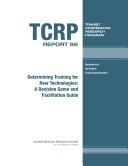| Listing 1 - 4 of 4 |
Sort by
|
Book
ISBN: 0309305810 0309305829 Year: 2014 Publisher: The National Academies Press
Abstract | Keywords | Export | Availability | Bookmark
 Loading...
Loading...Choose an application
- Reference Manager
- EndNote
- RefWorks (Direct export to RefWorks)
Book

ISBN: 0309278465 0309283426 Year: 2023 Publisher: Washington, D.C. : National Academies Press,
Abstract | Keywords | Export | Availability | Bookmark
 Loading...
Loading...Choose an application
- Reference Manager
- EndNote
- RefWorks (Direct export to RefWorks)
The United States has long made substantial investments in clinical research with the goal of improving the health and well-being of our nation. There is no doubt that these investments have contributed significantly to treating and preventing disease and extending human life. Nevertheless, clinical research faces a critical shortcoming. Currently, large swaths of the U.S. population, and those that often face the greatest health challenges, are less able to benefit from these discoveries because they are not adequately represented in clinical research studies. While progress has been made with representation of white women in clinical trials and clinical research, there has been little progress in the last three decades to increase participation of racial and ethnic minority population groups. This underrepresentation is compounding health disparities, with serious consequences for underrepresented groups and for the nation. At the request of Congress, Improving Representation in Clinical Trials and Research: Building Research Equity for Women and Underrepresented Groups identifies policies, procedures, programs, or projects aimed at increasing the inclusion of these groups in clinical research and the specific strategies used by those conducting clinical trials and clinical and translational research to improve diversity and inclusion. This report models the potential economic benefits of full inclusion of men, women, and racial and ethnic groups in clinical research and highlights new programs and interventions in medical centers and other clinical settings designed to increase participation.
Book

ISBN: 0309268613 Year: 2021 Publisher: Washington, D.C. : National Academies Press,
Abstract | Keywords | Export | Availability | Bookmark
 Loading...
Loading...Choose an application
- Reference Manager
- EndNote
- RefWorks (Direct export to RefWorks)
"The spring of 2020 marked a change in how almost everyone conducted their personal and professional lives, both within science, technology, engineering, mathematics, and medicine (STEMM) and beyond. The COVID-19 pandemic disrupted global scientific conferences and individual laboratories and required people to find space in their homes from which to work. It blurred the boundaries between work and non-work, infusing ambiguity into everyday activities. While adaptations that allowed people to connect became more common, the evidence available at the end of 2020 suggests that the disruptions caused by the COVID-19 pandemic endangered the engagement, experience, and retention of women in academic STEMM, and may roll back some of the achievement gains made by women in the academy to date. The Impact of COVID-19 on the Careers of Women in Academic Sciences, Engineering, and Medicine identifies, names, and documents how the COVID-19 pandemic disrupted the careers of women in academic STEMM during the initial 9-month period since March 2020 and considers how these disruptions - both positive and negative - might shape future progress for women. This publication builds on the 2020 report Promising Practices for Addressing the Underrepresentation of Women in Science, Engineering, and Medicine to develop a comprehensive understanding of the nuanced ways these disruptions have manifested. The Impact of COVID-19 on the Careers of Women in Academic Sciences, Engineering, and Medicine will inform the academic community as it emerges from the pandemic to mitigate any long-term negative consequences for the continued advancement of women in the academic STEMM workforce and build on the adaptations and opportunities that have emerged." --
COVID-19 Pandemic, 2020 --- -Women, Working. --- COVID-19. --- Work-Life Balance --- Social aspects --- Women. --- trends.


ISBN: 0309087724 0309087708 Year: 2021 Publisher: Washington, D.C. : National Academies Press,
Abstract | Keywords | Export | Availability | Bookmark
 Loading...
Loading...Choose an application
- Reference Manager
- EndNote
- RefWorks (Direct export to RefWorks)
Polymer-impregnated concrete. --- Fibrous composites. --- Roads --- Design and construction.
| Listing 1 - 4 of 4 |
Sort by
|

 Search
Search Feedback
Feedback About UniCat
About UniCat  Help
Help News
News